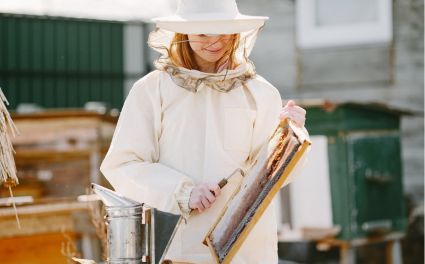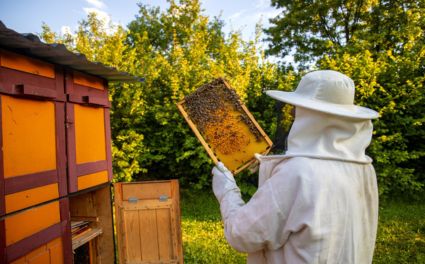Keeping your honey bees healthy through the cold months is one of the biggest challenges in beekeeping. Proper beehive insulation not only protects your colony from harsh winter temperatures but also supports year-round productivity. A well-insulated hive allows your bees to conserve energy, stay warm, and continue working efficiently.
This detailed guide explores why hive insulation is important, which materials to use, and how to prepare your hives for every season — while also emphasizing the safety of beekeepers using reliable beekeeping suits and gear.
Why Beehive Insulation Matters
Bees are remarkably resilient, but they rely on stable temperatures inside their hive. During winter, the cluster of bees generates heat by vibrating their flight muscles. Without proper insulation, that warmth escapes quickly, forcing the bees to consume more honey stores to survive.
Good insulation acts like a thermal blanket, trapping heat inside and preventing cold air from seeping in. It helps maintain a consistent temperature, reducing stress and energy loss for the colony.
Insulation is equally useful in summer — preventing overheating and moisture buildup. Stable hive temperatures support healthier brood development, stronger worker bees, and better honey production. For more insights on maintaining colony health through the year, you can explore Learn Beekeeping resources.

Choosing the Right Hive Insulation Materials
Selecting the right insulation material is critical for success. Different climates and hive setups call for different solutions.
-
Styrofoam: Lightweight, effective, and easy to handle. Ideal for areas with prolonged cold.
-
Reflective bubble wrap: Works as both insulation and a reflective barrier against heat loss.
-
Fiberglass boards: Excellent insulation but require care when handling.
-
Natural materials: Eco-friendly options like wood shavings, straw, or sawdust provide warmth while maintaining breathability.
Whichever material you choose, ensure it’s moisture-resistant and safe for bees. Avoid chemical coatings that could harm the colony or contaminate honey.
Step-by-Step: How to Insulate Your Beehive
1. Prepare and Inspect Your Hive
Start by cleaning your hive thoroughly. Remove any debris or mold that could affect ventilation. Inspect for cracks, loose joints, or gaps where cold air could enter and seal them carefully.
Wearing protective clothing like a full beekeeping suit ensures you can inspect comfortably without risk of stings. Durable and ventilated options like the Beekeeping Suits from OZ Armour are ideal for year-round use.
2. Apply Insulation
-
Wrap the hive: Use your chosen material to cover all sides, leaving the entrance unobstructed.
-
Secure properly: Fasten insulation with straps or waterproof tape so it stays in place during strong winds.
-
Add top insulation: Use an insulated inner cover or board on top to minimize heat loss.
If you’re working in colder conditions, pair your suit with durable beekeeping gloves for hand protection during setup. Explore well-fitted and flexible designs in Beekeeping Gloves.
3. Maintain Ventilation
One common mistake is over-insulating. Without proper airflow, condensation builds up inside the hive, dripping onto bees and causing them to freeze. Leave small ventilation gaps near the top to let moisture escape.
During inspections, wearing a beekeeping jacket and beekeeping veil combination provides freedom of movement while protecting your upper body and face. A good option can be found in Beekeeping Jackets and Beekeeping Veils.
4. Monitor and Adjust
Check your hives periodically throughout winter to ensure the insulation remains secure and dry. Replace or reinforce any areas affected by moisture or wind.
Keep an eye on food stores, too. Bees rely on their honey reserves during cold months, but you can supplement with sugar syrup or fondant if needed.
Seasonal Hive Insulation Practices
Insulation requirements shift with the seasons. Here’s how to adapt your hive maintenance throughout the year:
Winter
-
Wrap the hive with foam boards, tar paper, or hive wraps to retain heat.
-
Install an insulated inner cover to block drafts.
-
Create a windbreak using fences or natural barriers.
-
Ensure adequate honey reserves.
Summer
-
Remove winter wraps to prevent overheating.
-
Improve airflow with screened bottom boards.
-
Provide shade during peak heat hours.
-
Ensure bees have access to clean water to regulate temperature.
Regular Maintenance
-
Conduct seasonal inspections to check for damage.
-
Use insulation boards as needed.
-
Adjust hive management practices based on local climate.
For region-specific guidance and hive-care techniques, check Read More Blogs About Beekeeping — a great resource hub for all skill levels.
Benefits of Proper Hive Insulation
-
Healthier Bees: Stable internal temperatures prevent stress and disease, strengthening the colony.
-
Increased Honey Production: Less energy spent warming the hive means more for foraging and nectar processing.
-
Better Overwintering Survival: Insulated hives have higher colony survival rates during harsh winters.
Additionally, insulation reduces temperature shocks that can affect brood development and honey quality.
Practical Beekeeping Tips for Insulated Hives
-
Use hive stands: Elevate your hives to prevent cold and dampness from seeping in from the ground.
-
Install windbreaks: Shield your hives from strong winds to reduce heat loss.
-
Monitor regularly: Check for moisture buildup or signs of pests.
-
Avoid over-insulation: Too much insulation can trap moisture and harm the bees.
For added comfort during inspections, wear breathable beekeeping trousers paired with beekeeping ankle protection to keep bees from crawling up your legs. Quality gear like Beekeeping Trousers and Beekeeping Ankle Protection ensures complete protection.
If children help you with hive care, protect them with lightweight, full-coverage Beekeeping Kids Suits for a safe and educational experience.
Using Proper Beekeeping Equipments
Insulating hives and managing colonies effectively also require the right beekeeping equipments. Essential tools include hive tools, smokers, feeders, and brushes — each playing a vital role in gentle and efficient hive work. You can find professional-grade gear at Beekeeping Equipments.
Combining the right tools with protective clothing ensures safe and stress-free hive maintenance throughout the year.
Learning More About Bee Behavior
Understanding bee biology helps improve hive management. For example, knowing the difference between a bumblebee vs honeybee or identifying a bee nest vs wasp nest can prevent disturbances to natural pollinators. You can explore related topics such as difference between a beehive and a wasp nest, bumblebee vs carpenter bee, and do bee suits protect from wasps through The Secret Lives of Bees.
And in case of accidents, learn safe methods for removing a bee sting to avoid infections and reduce swelling.

Staying Safe with OZ Armour Protective Gear
While caring for your hive, it’s equally important to protect yourself. OZ Armour designs professional-grade protective wear, blending safety with comfort. Their suits are crafted from durable, breathable fabrics that offer sting protection and ventilation — a must when insulating hives or handling active colonies.
For beekeepers who enjoy style along with safety, pink bee suits from Pink Beekeeping Apparels are a vibrant, functional choice.
From beekeeping jackets to veils and gloves, each piece of OZ Armour gear ensures you can work confidently and comfortably — regardless of experience level.
Conclusion
Properly insulating your hive is one of the best ways to support your bees through every season. From preventing heat loss in winter to improving airflow in summer, insulation enhances colony health, productivity, and longevity.
Combine these hive-care techniques with the right beekeeping suits, gloves, and other protective wear from OZ Armour, and you’ll ensure both you and your honey bees stay safe and thriving.
For more seasonal advice, expert tips, and product insights, continue exploring Read More Blogs About Beekeeping and other helpful guides across the OZ Armour website — your trusted companion in safe, sustainable, and successful beekeeping.



